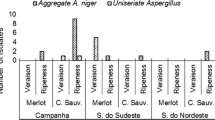Abstract
Fungi responsible for ochratoxin A (OTA) production have been studied especially on cereals, where Penicillium verrucosum and Aspergillus ochraceus are to be considered the main producers. Until 1998, these fungi were also believed to be responsible for the production of the toxin in grape, but OTA-producing A. carbonarius and A. niger were identified in dried vine fruits in 1999. Further studies pointed out that mycoflora potentially responsible for the presence of OTA in grapes are present in the field. Aspergilli are dominant to Penicillia, and among these Aspergilli section Nigri. A. carbonarius probably plays an important role because of the high percentage of positive strains and the amount of OTA produced. Aspergilli section Nigri are present on grape bunches early in the season and their frequency increases during later growth stages. At early veraison and ripening, the incidence of colonised berries is more related to the year than to the growth stage, but not to visible symptoms, since it is normal to isolate fungi from intact berries. Differences in ochratoxin content of berries have been detected between years, when the same vineyards, managed in the same way, showed high levels (1999) or the absence (2000) of the toxin. The results suggest that meteorological differences between years and grape-growing areas are responsible for differences in OTA levels, but the data are at present insufficient to draw firm conclusions.
Similar content being viewed by others
References
Abarca ML, Accensi F, Bragulat MR and Cabanes FJ (2001) Current importance of ochratoxin A-producing Aspergillus spp. Journal of Food Protection 64: 903-906
Battilani P and Pietri A (2002) Ochratoxin A in grape and wine. European Journal of Plant Pathology 108: 639-643
Battilani P, Pietri A, Bertuzzi T, Languasco L, Giorni P and Kozakiewicz Z (2002) Occurrence of ochratoxin A producing fungi in grape grown in Italy. Journal of Food Protection 66: 633-636
Cabanes FJ, Accensi F, Bragulat MR, Abarca ML, Minguez S and Pons A (2001) Aspergillus carbonarius is a source of Ochratoxin A-contamination in wine. In: Book of Abstracts 'Bioactive Fungal Metabolites-Impact and Exploitation' (p 51) University of Wales, Swansea, UK 2001
Campbell CL and Madden LV (1990) Introduction to Plant Disease Epidemiology, John Wiley & Sons, New York, USA
Codex Alimentarius Commission (1999) Codex Committee on Food Additives and Contaminants, 31st session, The Hague, the Netherlands, 22-26 March 1999
Da Rocha CAR, Palacios V, Combina M, Fraga ME, De Oliveira Rekson A, Magnoli CE and Dalcero AM (2002) Potential ochratoxin A producers from wine grapes in Argentina and Brazil. Food Additives and Contaminants 19: 408-414
Dutruc-Rosset G (1998) The State of Vitiviniculture in theWorld and the Statistical Information in 1998. Office International de la Vigne et du Vin
FAO/WHO, JECFA (2001) Safety evaluation of certain mycotoxins in food, WHO Food Additives Series 47, FAO Food and Nutrition Paper 74; Fifty-sixth meeting of the Joint FAO/WHO Expert Committee on Food Additives, Geneve, Switzerland, 6-15 February 2001, 281-415
Heenan CN, Shaw KJ and Pitt JI (1998) Ochratoxin A production by Aspergillus carbonarius and A. niger isolates and detection using coconut cream agar. Journal of Food Mycology 1: 67-72
Khatri NK and Shekhawat SS (1989) Fungicidal control of Aspergillus niger in date palm (in vitro). Pesticides 23: 55
Ospital M, Cazabeil JM, Betbeder AM, Tricard C, Creppy E and Medina B (1998) L'ochratoxine A dans les vins. Œnologie 169: 16-19
Sage L, Krivoboc S, Delbos E, Seigle-Murandi F and Creppy EE (2002) Fungal flora and ochratoxin A production in grapes and musts from France. Journal of Agriculture and Food Chemistry 50: 1306-1311
Suryawanshi AV and Deokar CD (2001) Effect of fungicides on growth and sporulation of fungal pathogens causing fruit rot of chilli. Madras Agricultural Journal 88: 181-182
Teren J, Varga J, Hamari Z, Rinyu E and Kevei F (1996) Immunochemical detection of ochratoxinAin black Aspergillus strains. Mycopathologia 134: 171-176
Zimmerli B and Dick R (1996) Ochratoxin A in table wine and grape-juice: Occurrence and risk assessment. Food Additives and Contaminants 13: 655-668
Author information
Authors and Affiliations
Rights and permissions
About this article
Cite this article
Battilani, P., Giorni, P. & Pietri, A. Epidemiology of Toxin-Producing Fungi and Ochratoxin a Occurrence in Grape. European Journal of Plant Pathology 109, 715–722 (2003). https://doi.org/10.1023/A:1026030408338
Issue Date:
DOI: https://doi.org/10.1023/A:1026030408338




